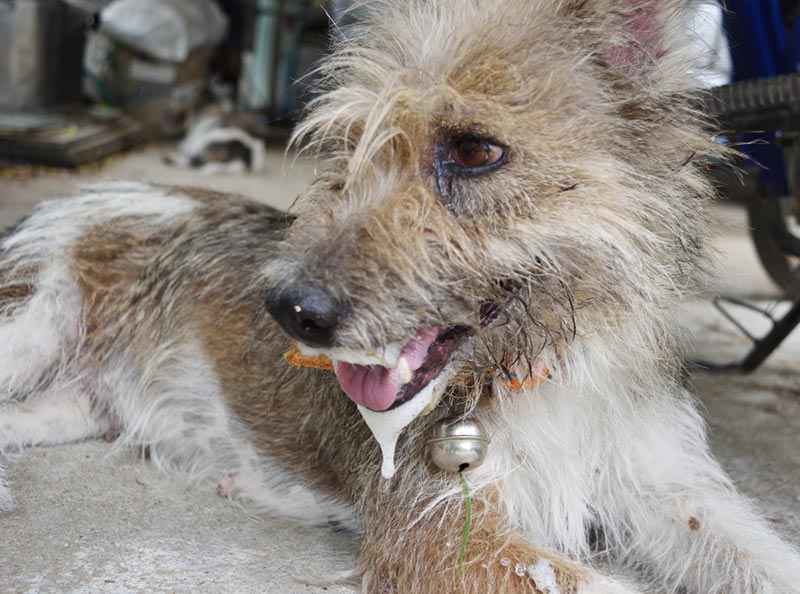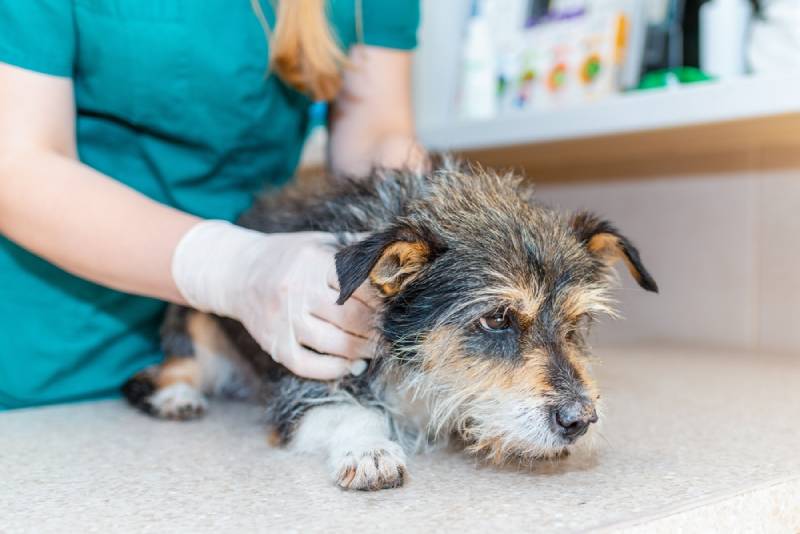Can a Dog Live With Rabies? Facts, Symptoms, & FAQ
Updated on

Just hearing the term “rabies” can be frightening for any dog owner. Movies like “Old Yeller” were traumatizing but certainly drove home the message that pets should be vaccinated against rabies. But have you ever wondered if rabies is always fatal for dogs?
There have been a few rare cases of dogs surviving rabies, but it is always fatal if the dog isn’t vaccinated or given booster shots right after becoming infected.
Rabies is a disease that must be taken seriously. Here, we get into how rabies works and what symptoms you should look out for.
What Is Rabies?
Rabies is a viral disease that is highly infectious to mammals, including pets. The rabies virus is zoonotic, which means it can be passed on to humans, and once symptoms start to present, it is 100% fatal¹.
It can be found worldwide, but several countries and continents are free from rabies. These include Antarctica, Australia, Iceland, Ireland, Japan, New Zealand, the Pacific Islands, the United Kingdom, and certain parts of Scandinavia.

How Is Rabies Transmitted?
The most common way that an animal or human becomes infected is through a bite from an animal infected with rabies. The virus enters the wound from the saliva of the infected animal. It’s quite uncommon for a dog to become infected with rabies in any other way than a bite wound, but it is possible if the saliva comes into contact with an open wound, scratch, or mucous membranes like the nose, eyes, or mouth.
The animals that most typically pass on the rabies virus vary depending on the location. In Europe, these tend to be foxes. In North America, they include raccoons, skunks, and bats, as well as foxes and coyotes.
In the United States, the bat tends to be the leading cause of human fatalities due to the bite being so small that many people don’t realize that they’ve been bitten. But worldwide, dogs¹ are the primary source of human rabies fatalities, up to 99%.
In Africa, Latin America, and Asia, stray dogs are the most common carriers. In these areas, human fatalities are also the highest.
After the person or animal has been bitten, the infested saliva enters the body, it travels along the nerves and toward the brain, but before it reaches the brain, it has an incubation period.
How Long Does the Virus Take to Incubate?

Before dogs start to exhibit rabies symptoms, there’s an incubation period. Several factors determine how long it takes the virus to incubate before the symptoms start to appear.
The incubation period can be from 10 days to a year or longer, but the average for dogs is 2 weeks up to 4 months. It depends on:
- How severe the bite is
- Where the dog was bitten — the closer the bite is to the spine and brain, the faster the virus reaches the brain
- How much of the virus is injected into the bite
During the incubation period, the animal doesn’t show any symptoms. They can’t pass on the virus because it won’t have reached their salivary glands yet.
What Are the Symptoms of Rabies?
The Prodromal Phase
The prodromal phase is the first phase when a dog starts to show signs of the rabies virus. One of the first signs is a noticeable change in temperament. Active dogs might become shy and nervous, and quiet dogs become hyper and agitated.
Other signs can include:
- Fever
- Anxiety
- Lethargy
- Vomiting
- Decrease in appetite
This phase typically lasts for about 2 to 3 days.
Paralytic or Dumb Rabies
After the first phase, there are two final stages. Dogs will either show one of these or a combination of both.
A common form that affects dogs is dumb or paralytic rabies, which presents as:
- Paralysis that gradually affects the limbs
- Incoordination
- Difficulty swallowing
- Excessive salivation
- Foaming at the mouth
- Difficulty breathing
- Distortion of the face
- Dropped jaw
- Seizures
- Appear to have something stuck in the mouth or throat

Furious Rabies
The second form is the one that most people are most familiar with, which is known as furious rabies:
- Aggression toward everyone and everything
- Highly excitable
- Pica (eating items that are inedible, such as eating garbage, earth, and stones)
- Gradual paralysis
- Inability to eat or drink
- Hypersensitivity to sound and light
- Seizures
After the virus reaches the brain, it also moves into the salivary glands, which is when the first phase of the clinical signs of rabies begins. The animal usually dies within 7 days after symptoms appear.
Do note that the fear of water, hydrophobia, isn’t listed as a symptom. It only affects humans infected with rabies.
FAQ
What Is the Treatment?
There is no treatment for wild animals, and they are either euthanized or die from the disease.
In many states and provinces, cats, ferrets, and dogs are required by law to be vaccinated against rabies. These pets usually receive their first vaccine by 3 months of age and continue with booster shots every year for the rest of their lives.
When a dog is bitten, particularly by a wild animal, it’s best to get a rabies booster shot as soon as possible, which might help fight the infection. They should also be quarantined for 10 days, but if they have never been vaccinated, the quarantine might be as long as 6 months.
Is There a Cure for Rabies?
Unfortunately, there is not. Once the animal starts exhibiting the physical signs of rabies, they will die within the week. The best thing to do is to have them euthanized, not only for safety reasons but also so the animal doesn’t suffer.
How Is Rabies Diagnosed?
The only way to know without a shadow of a doubt that an animal has rabies is by examining the brain tissue, which means the animal must already be dead. This is accomplished with a direct fluorescence antibody test.
The only way for a veterinarian to determine if an animal has rabies while alive is to observe the symptoms, followed by quarantine.

Can a Dog Survive Having Rabies?
There have been very few cases where dogs have survived, and it’s thought that the bite from the rabid animal only deposited a small amount of infected saliva into the wound. But particularly for dogs that aren’t vaccinated, rabies is fatal 100% of the time.
What If You or Your Dog Are Bitten?
If you encounter an animal that you suspect might have rabies, stay clear and ensure that your dog is also kept away. Wild animals with rabies will be acting strange and might try to approach you. Excess salivation is another indication that the animal has the disease.
Head to the closest emergency hospital or vet clinic, depending on who has received the bite. The vet or doctor will thoroughly clean the wound, which you shouldn’t do on your own unless you have rubber gloves and first-aid knowledge of treating a wound.
The rabies vaccine will also be administered at this time. Your next step is to notify the local health department about the rabid animal to prevent it from harming others.
Conclusion
Rabies is serious business. Cats and dogs should all be vaccinated every year, particularly with the rabies booster. You may never have to deal with the disease, but the vaccine can give you the peace of mind that you’re keeping your pet safe.
Even if there’s a slight chance that your dog can survive the disease, it isn’t worth the risk. There’s no cure, and once the symptoms of rabies are noticeable, it is a death sentence.
Featured Image Credit: SeventyFour, Shutterstock










